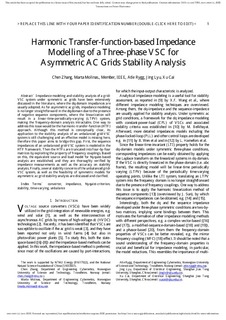| dc.contributor.author | Zhang, Chen | |
| dc.contributor.author | Molinas Cabrera, Maria Marta | |
| dc.contributor.author | Rygg, Atle | |
| dc.contributor.author | Lyu, Jing | |
| dc.contributor.author | Cai, Xu | |
| dc.date.accessioned | 2019-04-26T07:25:14Z | |
| dc.date.available | 2019-04-26T07:25:14Z | |
| dc.date.created | 2019-04-25T13:40:12Z | |
| dc.date.issued | 2019 | |
| dc.identifier.issn | 0885-8993 | |
| dc.identifier.uri | http://hdl.handle.net/11250/2595594 | |
| dc.description.abstract | Impedance modeling and stability analysis of a grid-VSC system under symmetric ac grids have been extensively discussed in the literature, where the dq domain impedances are usually adopted. As for asymmetric ac grids, impedance modeling is no longer straightforward in the dq domain due to the presence of negative sequence components, where the linearization will result in a linear-time-periodically-varying (LTPV) system, making the frequency-domain analysis intractable. One way to address this issue would be the harmonic-transfer-function (HTF) approach. Although this method is conceptually clear, its application to the stability analysis of an unbalanced grid-VSC system is still challenging and an effective model is missing here, therefore this paper aims to bridge this gap. First, the sequence impedances of an unbalanced grid-VSC system is modeled in the HTF framework. Then the HTFs are truncated into four-by-four matrices by exploiting the property of frequency couplings. Based on this, the equivalent source and load model for Nyquist-based analysis are established, and they are thoroughly verified by impedance measurements as well as the accuracy on stability analysis. Finally, several stability concerns of the unbalanced grid-VSC system, as well as the feasibility of symmetric models for asymmetric ac grid stability analysis are discussed and clarified. | nb_NO |
| dc.language.iso | eng | nb_NO |
| dc.publisher | Institute of Electrical and Electronics Engineers (IEEE) | nb_NO |
| dc.title | Harmonic Transfer-function-based Impedance Modelling of a Three-phase VSC for Asymmetric AC Grids Stability Analysis | nb_NO |
| dc.type | Journal article | nb_NO |
| dc.type | Peer reviewed | nb_NO |
| dc.description.version | acceptedVersion | nb_NO |
| dc.source.journal | IEEE transactions on power electronics | nb_NO |
| dc.identifier.doi | 10.1109/TPEL.2019.2909576 | |
| dc.identifier.cristin | 1693886 | |
| dc.description.localcode | © 2018 IEEE. Personal use of this material is permitted. Permission from IEEE must be obtained for all other uses, in any current or future media, including reprinting/republishing this material for advertising or promotional purposes, creating new collective works, for resale or redistribution to servers or lists, or reuse of any copyrighted component of this work in other works. | nb_NO |
| cristin.unitcode | 194,63,25,0 | |
| cristin.unitname | Institutt for teknisk kybernetikk | |
| cristin.ispublished | false | |
| cristin.fulltext | postprint | |
| cristin.qualitycode | 2 | |
